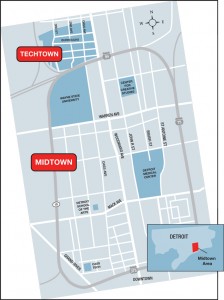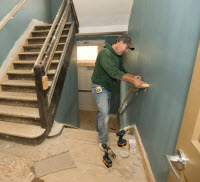How far will Midtown's momentum go?
There are two Detroits in the life of Theo Nicholaidis.
The first is a city of cafes and galleries, with his favorite crepe restaurant just down the block from his two-bedroom condo, a newly rehabbed unit with hardwood floors, a fireplace and deck.
“We go for walks at night through the neighborhood,” Nicholaidis said. “There are parks everywhere and community gardens. It’s really hopping.”
The 35-year-old systems administrator loves Midtown, where he moved earlier this year with the encouragement of a financial incentive from his employer, Wayne State University. But from the window of his living room, Nicholaidis can see another Detroit, one of boarded-up buildings and empty lots. And even though his mother lives there, Nicholaidis doesn’t feel at home. “Some of the streets are too bombed-out,” he said. “There’s crime and there’s no police presence.
“You couldn’t pay me even with an incentive to live in my mom’s area,” Nicholaidis said.
Detroit’s Midtown is in the midst of a high-profile, high-dollar renaissance drawing residents into a city that has been hemorrhaging people for a half century. Hundreds of young professionals have moved into the neighborhood just north of downtown in the past year, with more likely to follow as additional apartments and condos now under construction come on the market.
 National media have anointed Midtown the symbol of Detroit’s comeback. But the extent of the revitalization within the two-square-mile area known as Midtown isn’t known yet, let alone whether that change will ripple out to the rest of the city’s more than 130 square miles.
National media have anointed Midtown the symbol of Detroit’s comeback. But the extent of the revitalization within the two-square-mile area known as Midtown isn’t known yet, let alone whether that change will ripple out to the rest of the city’s more than 130 square miles.
Can the model used to bring two square miles of prime real estate back to life – a model based on large, gung-ho employers and cash incentives for new residents – be realistically applied to the rest of the city? What does a vibrant Midtown mean for the rest of Motown?
The fact that urban planners are even having that conversation is a massive step forward for a city better known for decay than development.
A billion dollars per square mile
In the past 10 years, there has been an astounding $2.4 billion in investment in Midtown, an area just north of downtown bordered by Interstate 75 on the south and east, the Lodge Freeway on the west and Interstate 94 on the north. That’s the equivalent of giving each of the 14,500 residents of Midtown a check for $165,000.
Detroit Medical Center spent $850 million on improvements to its campus, and Henry Ford Health System invested $500 million. Wayne State University added 1,660 dorm units.
(BRIDGE GALLERY: Midtown on the move)
About $400 million has been invested in residential housing, with more than 2,800 condos, lofts, apartments and single-family homes already added or in the works. Many units are being carved out of buildings that had been sitting dormant for years, simultaneously erasing blight and adding residents. Newberry Hall, across the street from the DMC and built in 1898 to house nurses, is one example of the rehab work in Midtown. When completed, it will hold 28 apartments.
“It’s a positive thing, building the community up,” said Ted Cash, Jr., a Midtown resident for six years. “I mean who wants to (live) in a community with empty streets and vacant buildings? No one wants to see that.”
In January three employer anchors in Midtown -- Wayne State, Henry Ford Health System and DMC -- launched an incentive program to encourage workers to move to the neighborhood. Employees can get $3,500 in rent assistance over two years, or up to $25,000 to help buy a home.
By September, the program, Live Midtown, had run through all of its $1.2 million. (Another $1 million is expected to be available in 2012).
About six out of 10 people getting these incentives lived outside of Detroit before moving to Midtown this year, said David Egner, president of the Hudson-Webber Foundation and the New Economy Initiative for Southeast Michigan. Egner thinks the percentage of new residents from outside Detroit will be higher in future years of the incentive program, because the program also offered the incentive to employees of the anchor entities already living in Midtown before the program launched.
Of those who purchased homes or lofts, 72 percent bought units that were previously vacant; about 80 percent of incentive users are under the age of 40.
One report this summer claimed Detroit’s greater downtown area had experienced a 59 percent increase in young professionals since 2000. But that figure, reached by mixing different types of federal data, is likely misleading. In fact, Kurt Metzger of Data Driven Detroit believes the number of young professionals across Detroit actually fell by more than 40 percent in the decade.
Neither figure is very relevant for measuring Midtown’s revitalization, which began in earnest in the past two years.
Lacking data, the most reliable way to gauge success may be counting dogs.
Melissa Smiley has two of them, a “shepherd mutt and a weasel mix,” which she and her partner Patricia Wren walk through Midtown daily. “We have a neighbor who’s lived here 10 years who said, ‘It’s only in the past two years I’ve seen dogs,’ ” Smiley noted.
Smiley and Wren moved from Ann Arbor to Midtown last December, and live in a 2,000-square-foot loft in a former Jeep dealership. The couple sold one of their cars and bought two bicycles.
“It’s a six-minute bike ride to work,” said the 35-year-old Smiley, who works at Data Driven Detroit. “We can walk to a dozen restaurants and all the museums.”
Wren commutes to Rochester daily, where she is an associate professor and director of the health sciences program at Oakland University.
Not qualifying for the incentive program (neither works for one of the anchor employers) didn’t stop them from plunking down $340,000 for their loft. “Nobody threw $20,000 at us to live here,” said Wren, 47. “Detroit was incentive enough.”
Patience Young, 21, is typical of those moving to the area – young, and more racially diverse than the city as a whole. “I had a really interesting conversation with a person at the bus stop the other day, who told me he was here for the riots, and how all the white people left,” said Young, who is white. “He said within two years his block that was totally mixed was down to half the population. He was really psyched about people moving in -- and I am, too.”
Detroit’s Midtown effort is modeled after a similar revitalization in Philadelphia, in a neighborhood around the University of Pennsylvania. In the 1980s, UPenn had about 25,000 employees, with an average salary of $50,000, yet the neighborhood surrounding the college was a war zone. “Employees didn’t live there -- there was huge disinvestment,” said Lisa Prasad, principal at U3 Ventures, an urban planning consulting firm inPhiladelphia. “The tipping point came when a graduate student was murdered just off campus.”
The university poured money into the neighborhood, including incentives for employees to move in. Today, the neighborhood “is a community of choice” in Philadelphia, Prasad said.
Detroit’s Midtown is in an even better position for a comeback, Prasad said, with its three anchors, 30,000 employees and another 30,000 students. The average salary of workers at Henry Ford, DMC and Wayne State is $20,000 higher than the average annual income of Detroit residents, Prasad noted. Getting those paychecks spent in Detroit rather than the suburbs would have a tremendous impact on local retailing and restaurants.
The other Detroit
Wayne State University law professor John Mogk shuttled a class of law students to a Detroit east side community service agency last week. “It was an eye opener for them,” Mogk said. “Some of them live in Midtown and go to school in Midtown, and weren’t familiar with the rest of the city.”
As chairman of the Michigan Council on Labor and Economic Growth and a past chairman of Habitat for Humanity Detroit, Mogk has strong opinions on urban development. “The activities in Midtown are a positive for Detroit,” he said. “But that’s low-hanging fruit. There’s nothing wrong with picking low-hanging fruit – but it’s not going to solve the social and economic issues facing the rest of the city.”
Mogk worries that the praise Detroit is receiving for the Midtown renaissance will cause officials to become complacent about revitalization efforts elsewhere.
“There are neighborhoods (of Detroit) that have been in freefall since the '50s,” Mogk said. “The city needs to be addressing those neighborhoods, too.”
Egner disagrees. “You’ve got to take this one bite at a time,” he said. “If anybody sets out to take on 138 square miles at once, they’re bound to fail."
Egner believes Midtown’s success will have a positive ripple effect across Detroit. As well-paid workers move into the city, “there will be more taxpayers, more voters,” Edgar said. “That helps the city financially and psychologically. And as those young people settle in, there will be more retail and services to support them, providing employment for people from other parts of the city.”
Spreading the gospel
The Midtown incentive program already has made believers of five downtown businesses, which announced their own incentive program this summer. Employees of Quicken Loans, Blue Cross Blue Shield, Compuware, DTE Energy and Strategic Staffing Solutions can get cash to move to six downtown neighborhoods, including Midtown. The employers are kicking in $4 million for the project.
Three years ago, Forbes magazine placed Detroit at the top of its list of “America’s Most Miserable Cities.” Recently, the same magazine called Detroit a “land of opportunity.”
“You have to build it over time, build on the thing you did before,” said Sue Mosey, president of Midtown Detroit, Inc. “It’s a challenging community with a major disinvestment problem. You have to be constantly transforming something.”
Bridge Magazine's Dana Hollowell contributed to this report.
Business Watch
Covering the intersection of business and policy, and informing Michigan employers and workers on the long road back from coronavirus.
- About Business Watch
- Subscribe
- Share tips and questions with Bridge Business Editor Paula Gardner
Thanks to our Business Watch sponsors.
Support Bridge's nonprofit civic journalism. Donate today.
See what new members are saying about why they donated to Bridge Michigan:
- “In order for this information to be accurate and unbiased it must be underwritten by its readers, not by special interests.” - Larry S.
- “Not many other media sources report on the topics Bridge does.” - Susan B.
- “Your journalism is outstanding and rare these days.” - Mark S.
If you want to ensure the future of nonpartisan, nonprofit Michigan journalism, please become a member today. You, too, will be asked why you donated and maybe we'll feature your quote next time!




